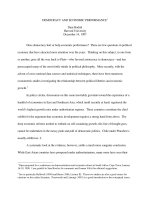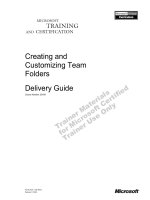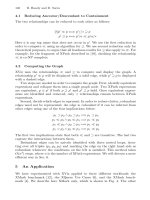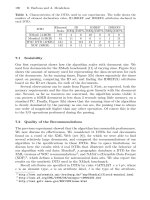Tài liệu Protocols and Transmission Theory pptx
Bạn đang xem bản rút gọn của tài liệu. Xem và tải ngay bản đầy đủ của tài liệu tại đây (1.77 MB, 98 trang )
Transmission and Protocol Theory 1
• Protocol History
• Signalling – Frequency vs. Bit Rate
Protocols Explained
Transmission and Protocol Theory 2
• Ethernet conception
• StarLAN
• Token Ring
• Cell vs. Packets – ATM vs. Ethernet
• Ethernet comes of age
Protocol History
Transmission and Protocol Theory 3
Protocol History
•
Born from the original Aloha Network in 1972
• Xerox, who pioneered the first PC with a GUI
commission Bob Metcalfe to develop networking from
their ALTO computers to Arpanet
• The breakthrough was a device that could listen before
transmitting, which allowed for full utilization of the
bandwidth speed (2.94Mbps)
• In 1977 they were issued the patent on CSMA/CD
(Carrier-Sense Multiple Access with Collision Detection)
Transmission and Protocol Theory 4
Protocol History
• The key principle behind Ethernets success was not it’s
speed early on or the way it transmitted within a
network, but Metcalfe’s vision to have a standardized
platform that WAS NOT
proprietary
• This was pushed further by joint efforts between Intel,
DEC and Xerox in the late 70’s through to the early 80’s
• Simultaneously the IEEE began working on
standardizing protocol developments, starting with
Ethernet, as Xerox continued to turn it’s patents over to
them in an effort to drive global adoption with a
standard platform
Transmission and Protocol Theory 5
Protocol History
• Metcalfe and others broke off on their own to form
3COM in 1979
• They released their first TCP/IP transceivers for UNIX
a full 18 Months before the IEEE standard
• The 3C100 Transceivers were being produced for DEC,
Intel and Sun Microsystems
• Both Apple and IBM were approached in an effort to
push networking for the developing PC market
• Apple said yes, but IBM said no because of their own
Token Ring developments
Transmission and Protocol Theory 6
Protocol History
• 3COM, without the cooperation of IBM, decided to
produce the highly successful ISA EtherLink adaptors for
IBM PC’s
• This was highly cost effective at the time ($950 USD)
and gained large acceptance
• Demand was driven not by “Personal” computing, but
rather by businesses adopting the PC
• Of course with so many computers within companies
the need to network grew
• 3COM met these demands and become the NIC
champion in the mid 80’s
Transmission and Protocol Theory 7
Protocol History
• Ethernet networks were first connected using Coax
cables
• 10Base5, running on RG-8 cable was capable of
distances up to 500m
• 10Base2, running on RG-58 cable was capable of
distances of 185m
• Although the distances were reduced using 10Base2,
acceptance was better due to reduced costs in cabling
infrastructure, as well as active hardware
• It was quickly realized that LAN connections did not
require 500m distances in the horizontal
Transmission and Protocol Theory 8
Protocol History – Thick vs. Thin
Cable AUI
Transceptor
Dispositive Connection
NIC 10Base5
Transceptor
Dispositive Connection
NIC 10Base2
Terminator
Terminator
Terminator
Vampire
Clamp
Connectors
RG 8 Coax
Ethernet cable
RG 8 Coax
Ethernet cable
Vampire
Clamp
Terminator
BNC Connector
BNC Connector
Transmission and Protocol Theory 9
Protocol History - StarLAN vs. Thick/Thin Bus
• Thin Ethernet had advantages over regular (thick)
Ethernet, in that the cables were cheaper and the
electronics were all located within the NIC. Both still had
drawbacks with their Bus architecture. MAC’s were
difficult. Cables could not be severed or the entire
network would go down. Termination at both ends was a
must!
• Intel and AT&T saw this as an opportunity to change
the architecture to a “Star” configuration
Transmission and Protocol Theory 10
Centralized Controller
Bus Topology
Star Topology
Protocol History StarLAN - Bus vs. Star
Transmission and Protocol Theory 11
Protocol History - StarLAN
• StarLAN offered advantages in its flexibility through
the ability to run on UTP cables (standard telephone
wire)
• The star configuration allowed the addition of circuits
without disturbing others
• It also offered a more cost effective means of network
deployment
• StarLAN had drawbacks in speed, only running at
1Mbps. 3COM did not adopt this technology for this very
reason
• The 386 processor speed would end StarLAN, but Star
Typology was born!
Transmission and Protocol Theory 12
Protocol History - Token Ring
• In 1985 IBM released 4Mbps Token
Ring, several years after Bob Metcalfe
approached IBM with Ethernet!
• At the time the speed was less than
half that of 10Mbps Ethernet, but had
the advantage of using a centralized
hub, similar to StarLAN
• It also used “structured cabling”
IBM shielded cable
• 1Mbps StarLAN had the same
centralized structure, but was 4 times
slower
Transmission and Protocol Theory 13
Centralized Controller
Bus Topology
Star Topology
Protocol History - Bus vs. Star vs. Ring
Centralized Controller
Ring Topology
Centralized (Hub)
control was an
advantage for
Star and Ring vs.
Bus
Transmission and Protocol Theory 14
Protocol History - Token Ring
• While Token Ring offered advantages over
Ethernet Bus Topology IBM made several mistakes
during the “War
• Licensing and standardization of Ethernet early on
meant that the technology was more cost effective
• Adoption of Ethernet by main industry players,
such as Sun, 3COM and Texas Instruments made
Token Ring less attractive
• IBM’s push to ATM Cell (vs. Ethernet Frames) had
several disadvantages
• Ethernet was, at the same time, becoming a Fibre
and UTP technology vs. STP only!
Transmission and Protocol Theory 15
IFG 8 Bytes 6 Bytes 6 Bytes 2 Bytes 46-1500Bytes 4 Bytes IFG 8 Bytes 6 Bytes 6 Bytes 2 Bytes 46-1500Bytes 4 Bytes
Preamble
Destination
Address
Source
Address
Type/Length Data/Payload
CRC/FCS
Preamble
Destination
Address
Source
Address
Type/Length Data/Payload
CRC/FCS
5 Bytes 48Bytes 5 Bytes 48Bytes 5 Bytes 48Bytes 5 Bytes 48Bytes 5 Bytes 48Bytes
Destination
Header
Data
Destination
Header
Data
Destination
Header
Data
Destination
Header
Data
Destination
Header
Data
Ethernet
Packet
ATM
Cell
• The Ethernet packet has far more overhead than the ATM cell
• The nature of ATM is to setup the conversation/connection and
stream the data between two nodes. This allows for QoS at a
90% efficiency
• The Ethernet packet does offer a larger payload, but also has
inter-frame gaps for timing
•The packet relies on Best-Effort Transmission and does not
offer true QoS and has a 98% efficiency
Protocol History - Cell vs. Packet – ATM vs. Ethernet
Transmission and Protocol Theory 16
Preamble
8 bytes
Destination
6 bytes
Source
6 bytes
Type
2 bytes
Data
46-1500 bytes
CRC/FCS
5 Bytes
Ethernet Packet
Protocol History - Packets are just like
letters
Transmission and Protocol Theory 17
Preamble
8 bytes
Destination
6 bytes
Source
6 bytes
Type
2 bytes
Data
46-1500 bytes
CRC/FCS
5 Bytes
Ethernet Packet
Protocol History - Even in different languages
Transmission and Protocol Theory 18
• ATM was developed in the late 70’s as a Carrier WAN
transmission protocol for both Voice and Data
• It was based on Broadband ISDN principles of offering QoS
• In the mid 90’s it was thought that WAN technology,
because of QoS and the ability to deliver real-time
applications such as voice reliably, would take over the LAN
as well
• Advancements in Ethernet speed and reliability however
made the QoS argument a mute point
• Cost of ownership for Ethernet vs. ATM also played a large
part into ATM’s demise
Protocol History - Cell vs. Packet – ATM vs. Ethernet
Transmission and Protocol Theory 19
Protocol History - Ethernet Comes of Age
• While other protocols offered advantages over Ethernet in
different areas such as QoS and speed, during different
stages of development, standardisation made Ethernet more
cost effective through the ease of technology licensing from
the IEEE
• Full Duplex transmission enabled Ethernet to talk and
listen simultaneously and greatly increase efficiency
• The development of Gigabit Ethernet increased speeds
within the LAN to levels that could support any real-time
application and increased bandwidth requirements of the
time
• QoS has been addressed through sheer pipe size and
prioritized packeting
Transmission and Protocol Theory 20
Protocol History - Ethernet Comes of Age
• Gigabit horizontal, 10Gig backbone, Layer 3 switching,
broadband wireless, migration into SAN’s, MAN’s and now
WAN’s have proliferated Ethernet from traditional Enterprise
networks out
• This has pushed infrastructure to develop and grow at an
incredible rate to keep up with speed and quantity demands
• We are now used to Ethernet increasing in speed 10 times
every few years
• What begins as a backbone technology to support
increasing numbers of horizontal connections, quickly
becomes the next horizontal speed to support newer, faster
peripheral devices
Transmission and Protocol Theory 21
Frequency vs. Bit Rate
• The True about protocol speeds and the
frequencies they require
• Encoding Schemes and how they really
work
• Sensitivity of new technology
• Why a Standard Platform is so important
Transmission and Protocol Theory 22
Technology
TX Pairs
Used
Data Rate
in Mbps
Per Pair
Total Data
Rate
Encoding
Zero of Freq
Spectrum (=clock
frequency)
Nyquist Min
Channel
Bandwidth
Cable
Category
Cable
Bandwidth
10Base-T 1 10Mbps 10Mbps Mancheste
r20MHz 10MHz 3 16MHz
100Base-TX 1 100Mbps 100Mbps MLT 3 125MHz 62.5MHz 5 100MHz
100Base-T4 3 33Mbps 100Mbps 8B/6T 25MHz 12.5MHz 3 16MHz
100Base-T2 2 50Mbps 100Mbps PAM 5 25MHz 12.5MHz 3 16MHz
1000Base-T 4 250Mbps 1000Mbps PAM 5 125MHz 62.5MHz 5e 100MHz
10GBase-T 4 2.5Gbps 10Gbps PAM 16 6
A
500MHz
Frequency vs. Bit Rate
• There has always been a misperception that frequency and
bit rate have a direct linear correlation. This is simply not
true
• As a result, several industry misnomers have lived on that
can easily be dispelled
Transmission and Protocol Theory 23
• ATM is a perfect example of misperception and industry
hype. The data rate for ATM 155, for example, is 155Mbps
• There were several technologies that played on a direct
correlation between the 155Mbps data rate and the 155MHz
frequency range having a direct correlation
• As in Ethernet, the Nyquist bandwidth is what is needed
for the receiver to interpret the data at half the clock speed
e.g. 77MHz!
• This is why Cat 5 cable, characterised to 100MHz, not
155MHz, is be used to support a 155Mbps protocol and Cat
5e cable for ATM 622
Technology
TX Pairs
Used
Data Rate
in Mbps
Per Pair
Total Data
Rate
Encoding
Zero of Freq
Spectrum (=clock
frequency)
Nyquist Min
Channel
Bandwidth
Cable
Category
Cable
Bandwidth
ATM 155 1 155Mbps 155Mbps MLT 3 (4B5B) 155MHz 77MHz 5 100MHz
ATM 622 4 155Mbps 622Mbps MLT 3 (4B5B) 155MHz 77MHz 5e 100MHz
Frequency vs. Bit Rate
Transmission and Protocol Theory 24
Frequency vs. Bit Rate
• Despite this industry misperception several marketers took
advantage of the 155Mbps data rate increase of 55Mbps
over 100BaseT and introduced cables and test solutions that
were rated to 155MHz!
• The WireScope 155 (Now the WireScope 350) is a perfect
example of testing to the 155MHz max frequency for
“assured ATM compliance”
• Some cable vendors followed suit and released Cat 5
cables that were tested to 155MHz, despite having no
standards requirement and no protocol need
• The same happened at the 350MHz frequency range, but
simply because a doubling of 155MHz to 310MHz did not
create an attractive “marketing message”!
Transmission and Protocol Theory 25
Definition of a Data Bit (RS232)
Figure 1
Digital Data Signal Representation and Bit Rate
Information is coded into groups of bits; generally groups of 8 bits. A
group of 8 bits is called a byte of information.
The text letter “E” is coded in 8 bits as “01001001” in one encoding scheme
called the ASCII.
Voltage
Time
11
0
0
000
1
1
11
t sec
Presence or absence o
pulse equals one bit
Presence or absence of pulse
equals one bit









